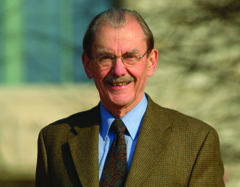August 08, 2016
 More than 2 million passengers boarded flights on average each day in the United States last year. The lives of those who travel by air are significantly more safe thanks to engineering research by Sigma Xi’s 2016 William Procter Prize for Scientific Achievement winner Jan Achenbach of Northwestern University. He will receive the prize and give a lecture at the Sigma Xi Annual Meeting and Student Research Conference this November in Atlanta.
More than 2 million passengers boarded flights on average each day in the United States last year. The lives of those who travel by air are significantly more safe thanks to engineering research by Sigma Xi’s 2016 William Procter Prize for Scientific Achievement winner Jan Achenbach of Northwestern University. He will receive the prize and give a lecture at the Sigma Xi Annual Meeting and Student Research Conference this November in Atlanta.
Achenbach was one of the researchers funded to help the Federal Aviation Administration (FAA) after disaster struck on April 28, 1988. Aloha Airlines Flight 243 was flying between islands of Hawaii when the roof departed from the plane, killing one flight attendant and seriously injuring eight people. Small cracks had joined together, which eventually led to the roof loss. The airline’s maintenance program had failed to detect the plane’s structural damage, and the FAA needed to know how to prevent such a failure from happening again.
Achenbach approached the challenge by using what he learned during his PhD studies. At Stanford University, he had investigated how waves move through solid objects, and later he wrote Wave Propagation in Elastic Solids. These projects were the foundation for his ability to pioneer methods in nondestructive evaluation, a method of testing an object’s structural integrity without taking it apart. Instead, ultrasound is used to penetrate a solid object, and the sound waves are reflected or scattered by flaws, such as cracks or corrosion.
When Achenbach began working on nondestructive evaluation, tests could only detect if a flaw existed. Achenbach developed a procedure that provided more details, identifying the flaw as well as its size and location. Today, nondestructive evaluations can determine if a repair is needed on a structure and it’s used for structural health monitoring. Sensors may be permanently installed on a critical structure to wirelessly transmit information about its structural integrity to a receiving point.
“It is a field that makes sure that planes are safe—at least safe from structural failure—that bridges are safe and that nuclear reactors are safe,” he said.
His work put him in the elite class of researchers who have received both the National Medal of Technology and Innovation and the National Medal of Science—the United States’ top prizes for science and technological achievements.
To watch an interview with Achenbach, go to his award page.